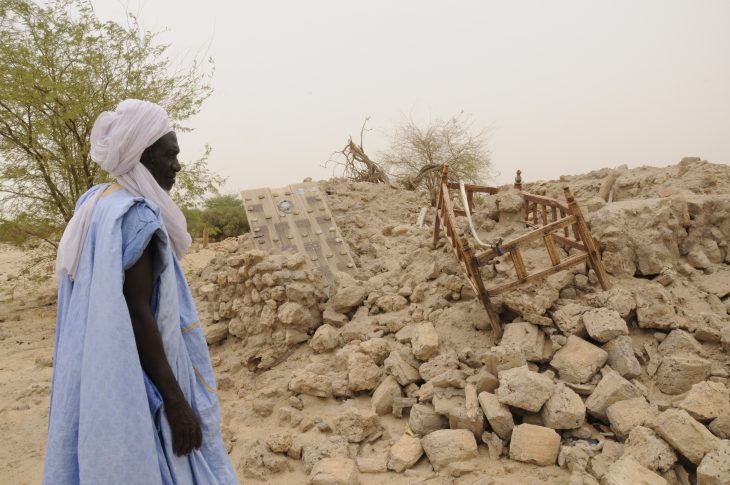A recent constellation of events appear to herald a shift in how the international community responds to threats to cultural property in armed conflict. At a time when many are calling international law into question and multilateral responses to emerging threats are losing steam, the last year has seen bold moves – from court cases, State initiatives, and action by the UN Security Council – that have recognized the importance of cultural property protection for peace and security, as well as the ability of third-party states to take on responsibility for its protection. Among these are the creation of “safe havens” for cultural property, following the example of the “Afghanistan Museum in Exile” in Switzerland. Could these developments broaden the horizon of the measures available to States looking to contribute to ensuring compliance with international law in armed conflicts?
This last year has seen a multi-faceted and robust international legal response to the destruction of cultural property and heritage in the context of armed conflicts. This response has come from several sources – the International Criminal Court, UN independent experts, the UN Security Council, and States. And it has been further bolstered by initiatives from the humanitarian community, UNESCO, and civil society. At a time when international humanitarian law appears to be routinely ignored by parties to protracted conflicts and there is a sense of fatigue and frustration among the international community, it is worth paying attention to this constellation of developments.
Timbuktu Shrines
On 27 September 2016, the International Criminal Court found Ahmad Al Faqi Al Mahdi guilty of the war crime of attacking historic and religious buildings in Timbuktu, Mali and sentenced him to nine years' imprisonment. This is an important case. Since a series of landmark cases at the International Criminal Tribunal for the Former Yugoslavia for shelling Dubrovnik, targeting the ancient Mostar bridge and attacking the national library in Sarajevo in the early 1990s, those responsible for looting or destroying cultural property – such as the Bamyan Buddhas in Afghanistan or Hindu Temples in Cambodia – have largely escaped punishment. Al Mahdi is the first cultural property destruction case heard by the ICC and sets an important precedent in the international response to the destruction of cultural property and heritage.
The case also recognizes such destruction as being among the most serious crimes, which has real implications. In recent months, as the reparations stage of proceedings has started, the court classified the inhabitants of Timbuktu as direct victims of the crime of destruction of cultural property, and "people throughout Mali" and "the international community" as indirect victims. It remains to be seen how the Chamber will address the material, psychological and potentially transgenerational harm caused by the destruction of the Timbuktu shrines, and what damages it will award to the victims. But the case has already gone a long way in recognizing the extent of the harm caused by attacks on cultural property – and may yet set an important precedent if it orders collective reparations that address the impact of the attacks on the community in and around Timbuktu, as well as to the international community at large.
International Strategies
Around the same time as the ICC Al Mahdi verdict, the UN Special Rapporteur in the field of cultural rights presented a dedicated report on the intentional destruction of cultural heritage to the 71st session of the General Assembly. In it, she set out an innovative human rights approach to the issue. Through examining the impact of such destruction on a range of human rights, the Special Rapporteur called for effective national and international strategies for preventing and holding accountable those alleged to have taken part in such destruction, as well as support for and protection of defenders of cultural heritage. The Special Rapporteur also set out concrete recommendations that States support cultural heritage professionals and defenders in their work, including through material and technical assistance, by granting asylum to at-risk cultural heritage professionals and defenders, ensuring that displaced cultural heritage professionals can continue taking part in the protection and reconstruction of their country’s cultural heritage, and facilitating their travel to enable them to access knowledge, best practices, advice and support in the field of cultural property protection. These are tangible measures that both place human rights at the centre of the protection response to cultural property destruction, and give third-party States practical tools through which to contribute to the protection of cultural heritage in armed conflicts around the world.
Soon after, in December 2016, 40 countries attended a conference in Abu Dhabi, United Arab Emirates, on Safeguarding Endangered Cultural Heritage and signed onto an outcome document – the Abu Dhabi Declaration – that marked a critical step toward third-party States taking on responsibility for the protection of cultural property in armed conflicts.
The Abu Dhabi Declaration
The declaration set out to pursue: “two ambitious, long term, goals to guarantee the further mobilization of the international community for the safeguarding of heritage: The creation of an international fund for the protection of endangered cultural heritage in armed conflict, which would help finance preventive and emergency operations, fight against the illicit trafficking of cultural artefacts, as well as contribute to the restoration of damaged cultural property; and
The creation of an international network of safe havens to temporarily safeguard cultural property endangered by armed conflicts or terrorism on their own territory, or if they cannot be secured at a national level, in a neighbouring country, or as a last resort, in another country, in accordance with international law at the request of the governments concerned, and taking into account the national and regional characteristics and contexts of cultural property to be protected.”
In addition to emphasizing the role of UN institutions, particularly UNESCO, the declaration called for the support of the Security Council in achieving these objectives. Following the Abu Dhabi Declaration, France, together with the United Arab Emirates, launched a fund, based in Geneva, that will take urgent action in emergency cases and contribute to the evacuation and reconstruction of endangered or damaged movable cultural heritage.
"Afghanistan museum in Exile "
The creation of “safe havens”, “refuges” or “shelters” for cultural property is a particularly innovative and exciting concept. It stems from Article 8 of the 1954 Hague Convention for the Protection of Cultural Property in the Event of Armed Conflict, which envisions specially protected movable cultural property being placed in “a limited number of refuges intended to shelter movable cultural property in the event of armed conflict,” away from any military objectives and removed from any risk of damage. In terms of practical implementation, the Swiss-organized “Afghanistan Museum in Exile” provides an encouraging example. The “Afghanistan Museum in Exile” opened in 2001 as a depository for the protection of Afghan cultural artefacts during the conflict in Afghanistan. The museum received more than 1,400 Afghan cultural objects from private donors and established a complete inventory by dedicated volunteer specialists. The success of this initiative was secured by the successful restitution of the 1,400 objects to the National Museum of Afghanistan in Kabul in 2006, under the umbrella of UNESCO. Following this example, the “safe havens” proposed in the Abu Dhabi declaration are guided by several principles – that the “shelter” State be responsible for safekeeping and preserving of entrusted cultural heritage, for its inventorying, and for returning it to its owner or established source when requested.In late March 2017, the UN Security Council unanimously adopted resolution 2347 – the first ever Security Council resolution to focus on cultural heritage.
UNESCO heralded the unanimous support to the resolution as reflecting a new recognition of the importance of heritage protection for peace and security. In addition to making reference to the two main outcomes of the 2016 Abu Dhabi conference, welcoming the intention to create an international fund for the protection of cultural heritage, as well as encouraging the creation the network of safe havens, resolution 2347 recognized that UN peacekeeping operations could encompass the protection of cultural heritage. While it remains to be seen whether the relevant authorities on the ground will request such assistance, as stipulated in the resolution, this signals that the UN Security Council is building on the experience of the Multidimensional Integrated Stabilization Mission in Mali (MINUSMA). MINUSMA’s mandate includes assisting the transitional authorities in the country with the protection of cultural and historic sites in collaboration with UNESCO, and is currently the only active UN peacekeeping mission that has this provision in its mandate.
Unesco's memorandum of understanding
These developments don’t stand alone. They have been bolstered by initiatives from the humanitarian community, UNESCO, civil society and cultural institutions. In February 2016, UNESCO signed a Memorandum of Understanding with the International Committee of the Red Cross (ICRC) that envisions the sharing of information on cultural property at risk in situations of armed conflict, and the ICRC assisting in rescuing, evacuating or undertaking emergency safeguarding measures to protect specific cultural property at imminent risk. This partnership has been rightly commended as a testament to the “growing global awareness that protecting cultural heritage is not just a cultural emergency but indeed a humanitarian imperative”. Cultural institutions have also taken on an increased role in this field. In the UK, the V&A Museum launched a Culture in Crisis Programme through which the museum works closely to support law-enforcement, nationally and internationally, and the British Armed forces to develop strategies to prevent the illicit trade of cultural goods. The British Museum is running the Iraq Heritage Management Training Scheme, through which it offers training to approximately 50 archaeologists from across Iraq in cultural heritage management and practical fieldwork skills over a four-year cycle. In the US, the Smithsonian Institute trained Syrian museum workers on the use of sandbags and other materials, techniques that they used to protect immovable ancient mosaics at a museum in Ma’arra Museum in Idlib. All of these initiatives appear to be part of a broader trend.
Looking at the big picture, these initiatives suggest a coalescing international legal response to the destruction of cultural property in armed conflict. Many of the proposed measures are concrete and actionable. This is especially encouraging at a time when there is a clear appetite for practical measures that can contribute to ensuring compliance with international law in protracted armed conflicts that appear to stymie international efforts. The broader response in the field of cultural property protection that we’ve seen over the last year – may demonstrate that we should broaden our horizons when looking for tools that can ensure respect for international humanitarian law, and what States can do to take on more of that responsibility.
Polina Levina Mahnad is a member of the International Committee of the Blue Shield Roster of Experts on cultural property protection. This article is written in her personal capacity.






